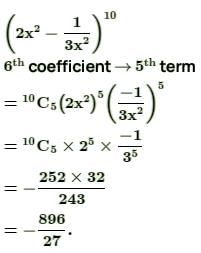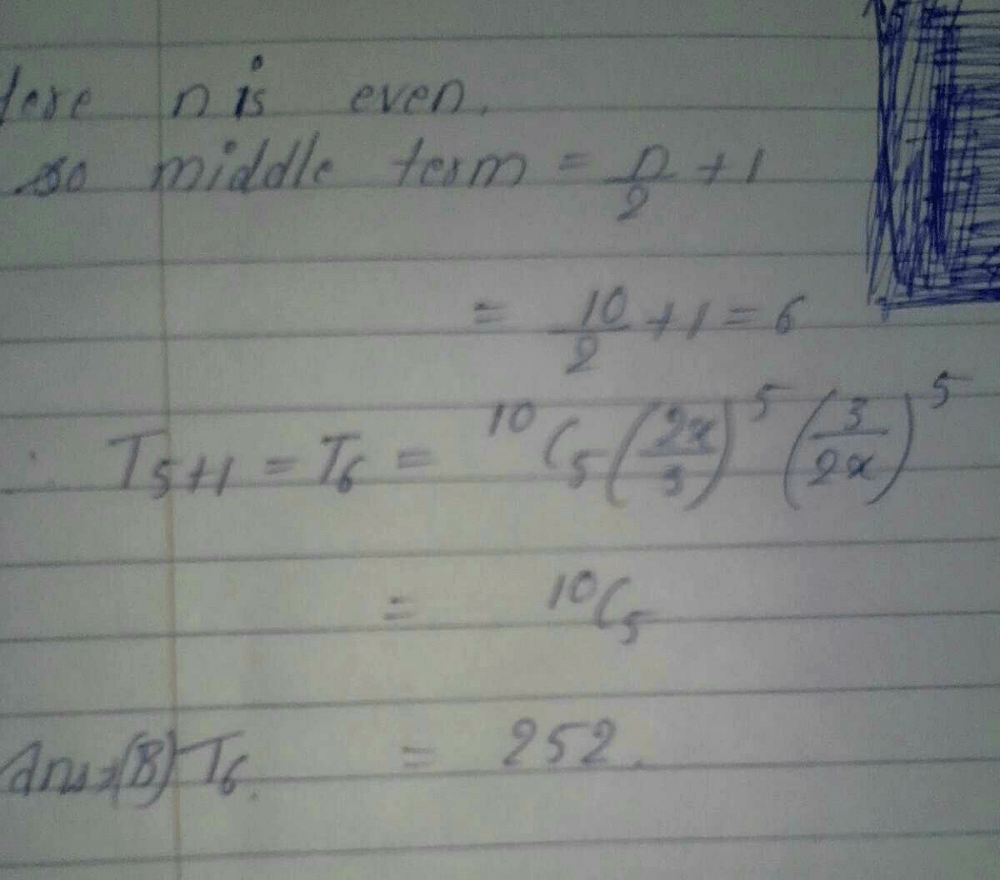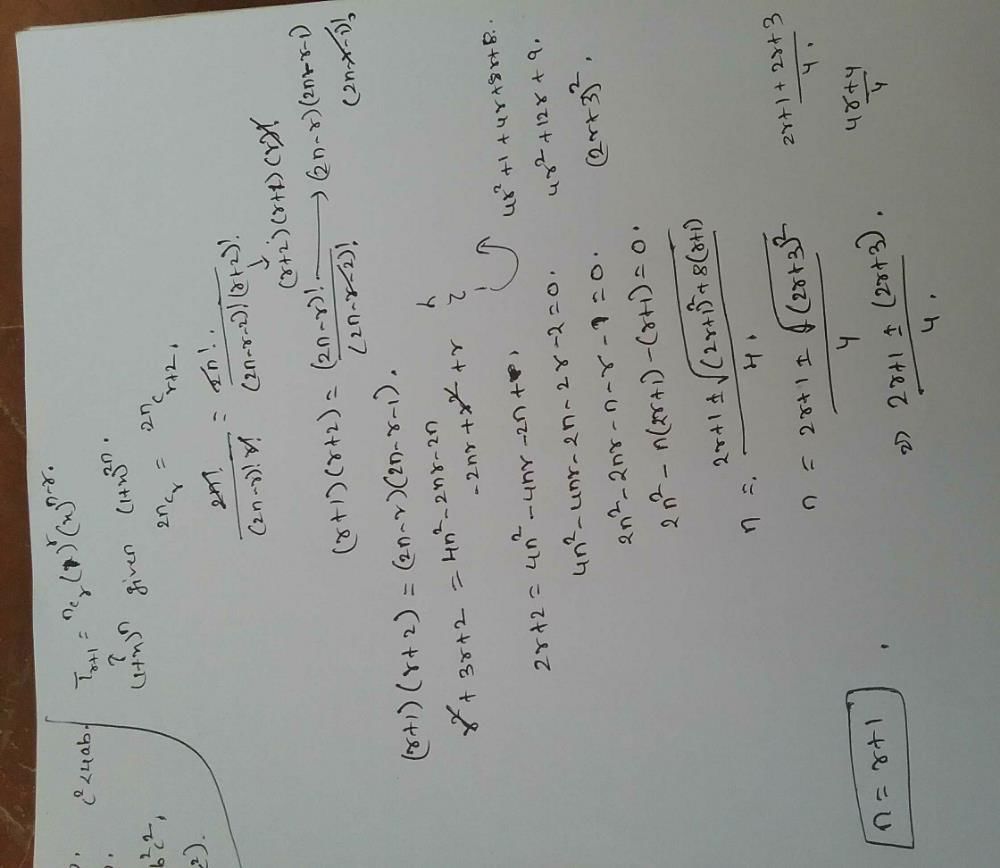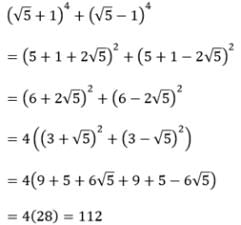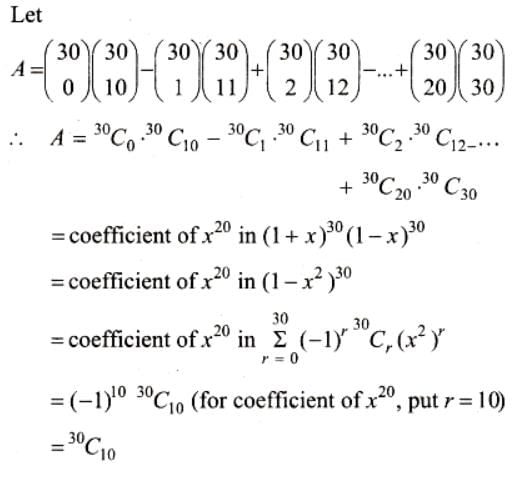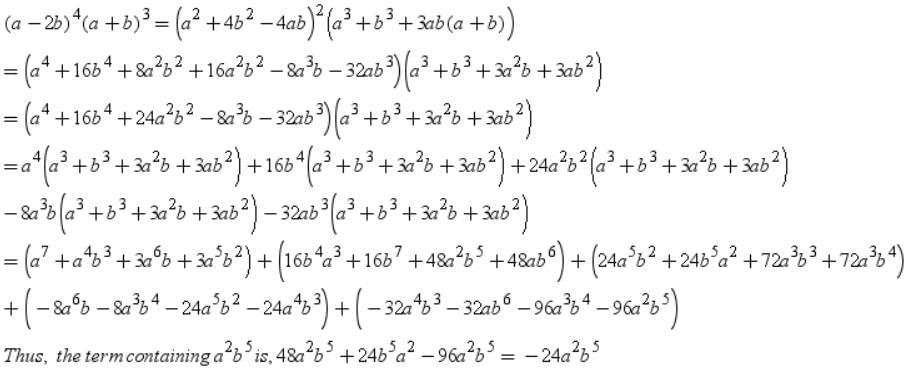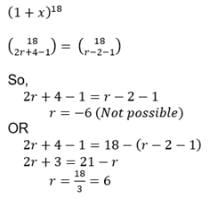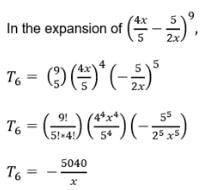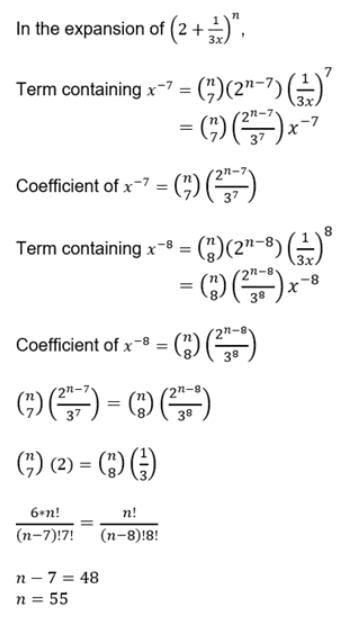All Exams >
NDA >
Mathematics for NDA >
All Questions
All questions of Binomial Theorem & its Simple Applications for NDA Exam
In the expansion of the binomial expansion (a + b)n, which of the following is incorrect ?
- a)The exponent of a decreases from n to 0.
- b)The number of terms is n+1.
- c)The exponent of b increases from 0 to n.
- d)The binomial coefficients in (a+b)n, which are equidistant from beginning and end are not equal.
Correct answer is option 'D'. Can you explain this answer?
In the expansion of the binomial expansion (a + b)n, which of the following is incorrect ?
a)
The exponent of a decreases from n to 0.
b)
The number of terms is n+1.
c)
The exponent of b increases from 0 to n.
d)
The binomial coefficients in (a+b)n, which are equidistant from beginning and end are not equal.
|
|
Krishna Iyer answered |
Correct Answer: d
Explanation:- The coefficient of terms (x+a)n equidistant from the beginning and the end are equal. These coefficients are known as the binomial coefficients.
nCr = nCn – r, r = 0,1,2,…,n.
The middle term in the expansion of (x + y)10 is the- a)6th term
- b)5th term
- c)average of 5th and 6th terms
- d)7th term
Correct answer is option 'A'. Can you explain this answer?
The middle term in the expansion of (x + y)10 is the
a)
6th term
b)
5th term
c)
average of 5th and 6th terms
d)
7th term
|
|
Vikas Kapoor answered |
Number of terms(n) = 10
Middle term = (n/2) + 1
Middle term = (n/2) + 1
= (10/2) + 1
= 5 + 1
= 6th term
= 5 + 1
= 6th term
The largest coefficient in the expansion of (1+x)24 is:- a)24C13
- b)24C12
- c)24C11
- d)24C24
Correct answer is option 'B'. Can you explain this answer?
The largest coefficient in the expansion of (1+x)24 is:
a)
24C13
b)
24C12
c)
24C11
d)
24C
24

|
Manish Aggarwal answered |
Largest coefficient in the expansion of (1+x)24
= 24C24/2
= 24C12
= 24C24/2
= 24C12
The number of terms in the expansion of (x – y + 2z)7 are:- a)35
- b)38
- c)36
- d)37
Correct answer is option 'C'. Can you explain this answer?
The number of terms in the expansion of (x – y + 2z)7 are:
a)
35
b)
38
c)
36
d)
37
|
|
Tejas Verma answered |
Here the number of terms can be calculated by:
= ((n+ 1) * (n+2)) /2
where, n =7
= ((n+ 1) * (n+2)) /2
where, n =7
∴ Number of terms = 36
The number of terms in the expansion of (2x - 3y)8 is- a)6
- b)9
- c)8
- d)5
Correct answer is option 'B'. Can you explain this answer?
The number of terms in the expansion of (2x - 3y)8 is
a)
6
b)
9
c)
8
d)
5
|
|
Aryan Khanna answered |
Since this binomial is to the power 8, there will be nine terms in the expansion.
In the expansion of (a+b)n, nN the number of terms is:- a)n + 1
- b)n
- c)n – 1
- d)an
Correct answer is option 'A'. Can you explain this answer?
In the expansion of (a+b)n, nN the number of terms is:
a)
n + 1
b)
n
c)
n – 1
d)
an
|
|
Sruthi Manoj answered |
For example if it is (a b)², then the expansion is a² 2ab b² which consist of 3 terms. Similarly (a b)¹= a b which consists of 2 terms. therefore that implies (a b) raised to n, then the no. of terms is n 1.
The expansion of  , in powers of x, is valid if
, in powers of x, is valid if- a)|x| > 2
- b)x < 2
- c)x > 2
- d)|x| < 2
Correct answer is option 'D'. Can you explain this answer?
The expansion of  , in powers of x, is valid if
, in powers of x, is valid if
a)
|x| > 2
b)
x < 2
c)
x > 2
d)
|x| < 2

|
Knowledge Hub answered |
In case of negative or fractional power, expansion (1+x)^n is valid only when |x| < 1
(6 - 3x)-1/2
= (6-1/2 (1 - x/2)-1/2)
So, this equation exists only when |x/2| < 1
|x| < 2
(6 - 3x)-1/2
= (6-1/2 (1 - x/2)-1/2)
So, this equation exists only when |x/2| < 1
|x| < 2
If n is a +ve integer, then the binomial coefficients equidistant from the beginning and the end in the expansion of (x+a)n are- a)additive inverse of each other
- b)multiplicative inverse of each other
- c)equal
- d)nothing can be said
Correct answer is option 'C'. Can you explain this answer?
If n is a +ve integer, then the binomial coefficients equidistant from the beginning and the end in the expansion of (x+a)n are
a)
additive inverse of each other
b)
multiplicative inverse of each other
c)
equal
d)
nothing can be said
|
|
Hansa Sharma answered |
(x+a)n = nC0 xn + nC1 x(n-1) a1 + nC2 x(n-2) a2 + ..........+ nC(n-1) xa(n-1) + nCn an
Now, nC0 = nCn, nC1 = nCn-1, nC2 = nCn-2,........
therefore, nCr = nCn-r
The binomial coefficients equidistant from the beginning and the end in the expansion of (x+a)n are equal.
Now, nC0 = nCn, nC1 = nCn-1, nC2 = nCn-2,........
therefore, nCr = nCn-r
The binomial coefficients equidistant from the beginning and the end in the expansion of (x+a)n are equal.
The value of 1261/3 upto three decimals is- a)5.013
- b)5.014
- c)5.012
- d)5.011
Correct answer is option 'A'. Can you explain this answer?
The value of 1261/3 upto three decimals is
a)
5.013
b)
5.014
c)
5.012
d)
5.011
|
|
Hiral Choudhary answered |
To find the value of 1261/3 upto three decimals, we can use the long division method or a calculator to obtain the quotient.
Long division method:
- We first write 1261 as the dividend and 3 as the divisor.
- We then perform the division as follows:
4.203666...
- We stop at three decimal places, which gives us the final answer as 5.013.
Therefore, the correct option is A) 5.013.
Long division method:
- We first write 1261 as the dividend and 3 as the divisor.
- We then perform the division as follows:
4.203666...
- We stop at three decimal places, which gives us the final answer as 5.013.
Therefore, the correct option is A) 5.013.
the coefficient of xn in the expansion of 
- a)n
- b)2n
- c)4n
- d)zero
Correct answer is option 'C'. Can you explain this answer?
the coefficient of xn in the expansion of 
a)
n
b)
2n
c)
4n
d)
zero
|
|
Suresh Reddy answered |
[(1+x)/(1−x)]2
⇒ (1+x)2(1−x)-2
⇒ (1 + x2 + 2x)[1 + 2x + 3x2 +..... +(n−1)xn-2 + nxn-1 + (n+1)xn +...]
coeff of xn will be given by
(I) When 1 will be multiplied by (n+1)xn
(II) When x2 will be multiplied by (n−1)xn-1
(III) When 2x will be multiplied by nxn-1
∴ coeff. of xn = n + 1 + n − 1 + 2n
= 4n
⇒ (1+x)2(1−x)-2
⇒ (1 + x2 + 2x)[1 + 2x + 3x2 +..... +(n−1)xn-2 + nxn-1 + (n+1)xn +...]
coeff of xn will be given by
(I) When 1 will be multiplied by (n+1)xn
(II) When x2 will be multiplied by (n−1)xn-1
(III) When 2x will be multiplied by nxn-1
∴ coeff. of xn = n + 1 + n − 1 + 2n
= 4n
What is the coefficient of x5 in the expansion of (1-x)-6 ?- a)252
- b)250
- c)-252
- d)251
Correct answer is option 'A'. Can you explain this answer?
What is the coefficient of x5 in the expansion of (1-x)-6 ?
a)
252
b)
250
c)
-252
d)
251
|
|
Preeti Iyer answered |
(1-x)-6
=> (1-x)(-6/1)
It is in the form of (1-x)(-p/q), p =6, q=1
=> (1-x)(-6/1)
It is in the form of (1-x)(-p/q), p =6, q=1
(1-x)(-p/q) = 1+p/1!(x/q)1 + p(p+q)/2!(x/q)2 + p(p+q)(p+2q)/3!(x/q)3 + p(p+q)(p+2q)(p+3q)/4!(x/q)4........
= 1+6/1!(x/1)1 + 6(7)/2!(x/1)2 + 6(7)(8)/3!(x/1)3 + 6(7)(8)(9)/4!(x/1)4 +.......................
So, coefficient of x5 is (6*7*8*9*10)/120
= 252
= 252
If in the expansion of (1+x)20, the coefficients of rth and (r+4)th terms are equal, then the value of r is equal to:- a)9
- b)7
- c)10
- d)8
Correct answer is option 'A'. Can you explain this answer?
If in the expansion of (1+x)20, the coefficients of rth and (r+4)th terms are equal, then the value of r is equal to:
a)
9
b)
7
c)
10
d)
8
|
|
Raghav Bansal answered |
Coefficients of the rth and (r+4)th terms in the given expansion are Cr−120 and 20Cr+3.
Here,Cr−120 = 20Cr+3
⇒ r−1+r+3 = 20
[∵ if nCx = nCy ⇒ x = y or x+y = n]
Here,Cr−120 = 20Cr+3
⇒ r−1+r+3 = 20
[∵ if nCx = nCy ⇒ x = y or x+y = n]
⇒ r = 2 or 2r = 18
⇒ r = 9
⇒ r = 9
The coefficient of y in the expansion of (y² + c/y)5 is - a)10c
- b)10c²
- c)10c³
- d)None of these
Correct answer is option 'C'. Can you explain this answer?
The coefficient of y in the expansion of (y² + c/y)5 is
a)
10c
b)
10c²
c)
10c³
d)
None of these
|
|
Varun Kapoor answered |
Given, binomial expression is (y² + c / y)5
Now, Tr+1 = 5Cr × (y²)5-r × (c / y)r
= 5Cr × y10-3r × Cr
Now, 10 – 3r = 1
⇒ 3r = 9
⇒ r = 3
So, the coefficient of y = 5C3 × c³ = 10c³
Now, Tr+1 = 5Cr × (y²)5-r × (c / y)r
= 5Cr × y10-3r × Cr
Now, 10 – 3r = 1
⇒ 3r = 9
⇒ r = 3
So, the coefficient of y = 5C3 × c³ = 10c³
What is the general term in the expansion of (2y-4x)44?- a)

- b)

- c)

- d)

Correct answer is option 'A'. Can you explain this answer?
What is the general term in the expansion of (2y-4x)44?
a)
b)
c)
d)
|
|
Om Desai answered |
n = 44, p = 2y q = -4x
General term of (p+q)n is given by
T(r+1) = nCr . pr . q(n-r)
= 44Cr . (2y)r . (-4x)(44-r)
General term of (p+q)n is given by
T(r+1) = nCr . pr . q(n-r)
= 44Cr . (2y)r . (-4x)(44-r)
The coefficient of x4 in the expansion of (1 + x + x2 + x3)n is:
- a)nC4 + nC2
- b)nC4 + nC2+ nC4.nC2
- c)nC4 + nC2+ nC1.nC2
- d)nC4
Correct answer is option 'C'. Can you explain this answer?
The coefficient of x4 in the expansion of (1 + x + x2 + x3)n is:
a)
nC4 + nC2
b)
nC4 + nC2+ nC4.nC2
c)
nC4 + nC2+ nC1.nC2
d)
nC4
|
|
Gaurav Kumar answered |
x4 can be achieved in the following ways:
x4 . 1(n-4) . (x2)0 . (x3)0
Hence, coefficient will be nC4 .
x2 . 1(n-3) . (x2)1 . (x3)0
Hence, coefficient will be 3nC3.
x1 . 1(n-2) . (x2)0 . (x3)1
Hence, coefficient will be 2nC2.
x0 . 1(n-2) .(x2)2 .(x3)0
Hence, coefficient will be nC2 .
Hence, the required coefficient will be
nC4 + 3nC3 + 3nC2
= nC4 + 3(nC3 + nC2).
= nC4 + 3(n+1C3).
= nC4 + nC2 + nC1 . nC2
x4 . 1(n-4) . (x2)0 . (x3)0
Hence, coefficient will be nC4 .
x2 . 1(n-3) . (x2)1 . (x3)0
Hence, coefficient will be 3nC3.
x1 . 1(n-2) . (x2)0 . (x3)1
Hence, coefficient will be 2nC2.
x0 . 1(n-2) .(x2)2 .(x3)0
Hence, coefficient will be nC2 .
Hence, the required coefficient will be
nC4 + 3nC3 + 3nC2
= nC4 + 3(nC3 + nC2).
= nC4 + 3(n+1C3).
= nC4 + nC2 + nC1 . nC2
Which of the following is divisible by 25:- a)6n - 5n + 1
- b)6n + 5n
- c)6n - 5n
- d)6n - 5n - 1
Correct answer is option 'D'. Can you explain this answer?
Which of the following is divisible by 25:
a)
6n - 5n + 1
b)
6n + 5n
c)
6n - 5n
d)
6n - 5n - 1
|
|
Riya Banerjee answered |
we can write (6ⁿ ) = (1 + 5)ⁿ
we know, according to binomial theorem,
(1 + x)ⁿ = 1 + nx + n(n-1)x²/2! + n(n-1)(n-2)x³/3! +.............∞ use this here,
(6)ⁿ = (1 + 5)ⁿ = 1 + 5n + n(n-1)5²/2! + n(n-1)(n-2)5³/3! +...........∞
= 1 + 5n + 5²{ n(n-1)/2! + n(n-1)(n-2)5/3! +.......∞}
Let P = n(n-1)/2! + n(n-1)(n-2)5/3! +.........∞
6ⁿ = 1 + 5n + 25P
6ⁿ - 5n = 1 + 25P -------(1)
but we know, according to Euclid algorithm ,
dividend = divisor × quotient + remainder ---(2)
compare eqn (1) to (2)
we observed that 6ⁿ -5 n always leaves the remainder 1 when divided by 25
we know, according to binomial theorem,
(1 + x)ⁿ = 1 + nx + n(n-1)x²/2! + n(n-1)(n-2)x³/3! +.............∞ use this here,
(6)ⁿ = (1 + 5)ⁿ = 1 + 5n + n(n-1)5²/2! + n(n-1)(n-2)5³/3! +...........∞
= 1 + 5n + 5²{ n(n-1)/2! + n(n-1)(n-2)5/3! +.......∞}
Let P = n(n-1)/2! + n(n-1)(n-2)5/3! +.........∞
6ⁿ = 1 + 5n + 25P
6ⁿ - 5n = 1 + 25P -------(1)
but we know, according to Euclid algorithm ,
dividend = divisor × quotient + remainder ---(2)
compare eqn (1) to (2)
we observed that 6ⁿ -5 n always leaves the remainder 1 when divided by 25
The general term in the expansion of (a - b)n is- a)Tr+1 = (-1)r nCr an-r br
- b)Tr+1 = nCr an-r br
- c)Tr+1 = nCr ar br
- d)Tr+1 = (-1)r nCr ar br
Correct answer is option 'A'. Can you explain this answer?
The general term in the expansion of (a - b)n is
a)
Tr+1 = (-1)r nCr an-r br
b)
Tr+1 = nCr an-r br
c)
Tr+1 = nCr ar br
d)
Tr+1 = (-1)r nCr ar br
|
|
Poonam Reddy answered |
If a and b are real numbers and n is a positive integer, then:
(a - b)n = nC0 an + nC1 a(n – 1) b1 + nC2 a(n – 2) b2+ ...... + nCr a(n – r) br+ ... + nCnbn,
(a - b)n = nC0 an + nC1 a(n – 1) b1 + nC2 a(n – 2) b2+ ...... + nCr a(n – r) br+ ... + nCnbn,
The general term or (r + 1)th term in the expansion is given by:
Tr + 1 = (-1)Cr a(n–r) br
Tr + 1 = (-1)Cr a(n–r) br
If 2nd, 3rd and 4th terms in the expansion of (x+a)n are 240, 720 and 1080 respectively, then the value of n is- a)15
- b)20
- c)5
- d)10
Correct answer is option 'C'. Can you explain this answer?
If 2nd, 3rd and 4th terms in the expansion of (x+a)n are 240, 720 and 1080 respectively, then the value of n is
a)
15
b)
20
c)
5
d)
10

|
Shiksha Academy answered |
General term Tr+1 of (x+y)n is given by
Tr+1 = nCr xn-r yr
T2 = nC2 xn-2 y = 240
T3 = nC3 xn-3 y2 = 720
T4 = nC4 xn-4 y3 = 1080
T3/T2 = [(n-1)/2] * [y/x] = 3......(1)
T4/T2 = {[(n-1)(n-2)]/(3*2)} * x2/y2 = 9/2
T4/T3 = [(n-2)/3] * [y/x] = 3/2...(2)
Dividing 1 by 2
[(n-1)/2] * [3/(n-2)] = 2
⇒ 3n−3 = 4n−8
⇒ 5 = n
Tr+1 = nCr xn-r yr
T2 = nC2 xn-2 y = 240
T3 = nC3 xn-3 y2 = 720
T4 = nC4 xn-4 y3 = 1080
T3/T2 = [(n-1)/2] * [y/x] = 3......(1)
T4/T2 = {[(n-1)(n-2)]/(3*2)} * x2/y2 = 9/2
T4/T3 = [(n-2)/3] * [y/x] = 3/2...(2)
Dividing 1 by 2
[(n-1)/2] * [3/(n-2)] = 2
⇒ 3n−3 = 4n−8
⇒ 5 = n
n-1Cr = (k2 - 3). nCr + 1 [JEE 2004 (Scr.)]- a)

- b)

- c)

- d)

Correct answer is option 'D'. Can you explain this answer?
n-1Cr = (k2 - 3). nCr + 1 [JEE 2004 (Scr.)]
a)
b)
c)
d)
|
|
Rohit Jain answered |
(n - 1)!/{r! × (n - 1 - r)!} = (k² - 3) × n!/(r + 1)!(n - r - 1)!
or, (n - 1)!/r! = (k² - 3) × n!/(r + 1)!
or, (n - 1)!/r! = (k² - 3) × n(n - 1)!/(r + 1)r!
or, 1/1 = (k² - 3) × n/(r + 1)
or, (r + 1)/n = (k² - 3)
we know, r and n are integers so, (r + 1)/n (0, 1]
so, 0 < (r + 1)/n ≤ 1
or, 0 < k² - 3 ≤ 1
or, 3 < k² ≤ 4
or, √3 < k ≤ 2 , -2 ≤ k < -√3
hence, k (√3, 2]
or, (n - 1)!/r! = (k² - 3) × n!/(r + 1)!
or, (n - 1)!/r! = (k² - 3) × n(n - 1)!/(r + 1)r!
or, 1/1 = (k² - 3) × n/(r + 1)
or, (r + 1)/n = (k² - 3)
we know, r and n are integers so, (r + 1)/n (0, 1]
so, 0 < (r + 1)/n ≤ 1
or, 0 < k² - 3 ≤ 1
or, 3 < k² ≤ 4
or, √3 < k ≤ 2 , -2 ≤ k < -√3
hence, k (√3, 2]
The coefficient of x3 in the binomial expansion of 
- a)792m5
- b)942m7
- c)330m4
- d)792m6
Correct answer is option 'C'. Can you explain this answer?
The coefficient of x3 in the binomial expansion of 
a)
792m5
b)
942m7
c)
330m4
d)
792m6
|
|
Geetika Shah answered |
T(r+1) = 11Cr x(11-2r) (m/r)r (-1)r
= 11Cr x(11-2r) mr (-1)r
Coefficient of x3 = 11 - 2r = 3
8 = 2r
r = 4
T5 = 11C4 x3 m4 (-1)
Coefficient of x3 = 11C4 m4
= 330 m4
= 11Cr x(11-2r) mr (-1)r
Coefficient of x3 = 11 - 2r = 3
8 = 2r
r = 4
T5 = 11C4 x3 m4 (-1)
Coefficient of x3 = 11C4 m4
= 330 m4
The coefficient of x17 in the expansion of (x- 1) (x- 2) …..(x – 18) is- a)- 171
- b)342
- c)171/2
- d)684
Correct answer is option 'A'. Can you explain this answer?
The coefficient of x17 in the expansion of (x- 1) (x- 2) …..(x – 18) is
a)
- 171
b)
342
c)
171/2
d)
684

|
Infinity Academy answered |
The coefficient of x17 is given by
−1 + (−2) + (−3) + ….. (−18)
= −1 − 2 − 3….. − 18
= − (18(18+1))/2
= − 9(19)
= − 171
−1 + (−2) + (−3) + ….. (−18)
= −1 − 2 − 3….. − 18
= − (18(18+1))/2
= − 9(19)
= − 171
(a) Coefficient of t24 in the expansion of (1 + t2)12 (1 + t12) (1 + t24) is [JEE 2003 (Scr.), 3](b) Prove that : [JEE 2003 (Mains),2]
[JEE 2003 (Mains),2]- a)12C6 + 2
- b)12C6+1
- c) 12C6
- d)None
Correct answer is option 'A'. Can you explain this answer?
(a) Coefficient of t24 in the expansion of (1 + t2)12 (1 + t12) (1 + t24) is [JEE 2003 (Scr.), 3]
(b) Prove that :
a)
12C6 + 2
b)
12C6+1
c)
12C6
d)
None
|
|
Om Desai answered |
(1+x)12 (1+x12) (1+x24)
= [C0 + C1x2 + C2x4 + C3x6 + C4x8 +.......C12x24) (1 + x12 + x24 + x36)
= x24(12C0 + 12C6 + 12C12)
= 1 + 12C6 + 1
= 12C6 + 2
= [C0 + C1x2 + C2x4 + C3x6 + C4x8 +.......C12x24) (1 + x12 + x24 + x36)
= x24(12C0 + 12C6 + 12C12)
= 1 + 12C6 + 1
= 12C6 + 2
In the expansion of (1+x)60, the sum of coefficients of odd powers of x is- a)261
- b)260
- c)259
- d)none of these.
Correct answer is option 'C'. Can you explain this answer?
In the expansion of (1+x)60, the sum of coefficients of odd powers of x is
a)
261
b)
260
c)
2
59
d)
none of these.
|
|
Mohit Mittal answered |
C is correct as
sum of ( 1+ x )^60 gives 2^60 which includes both even and odd powers of x
so for only one type of power ( odd power) of x we divide 2^ 60 by 2 so we get 2^ 59
sum of ( 1+ x )^60 gives 2^60 which includes both even and odd powers of x
so for only one type of power ( odd power) of x we divide 2^ 60 by 2 so we get 2^ 59
Let an denote the number of all n-digit positive integers formed by the digits 0, 1 or both such that no consecutive digits in them are 0. Let bn = the number of such n-digit integers ending with digit 1 and cn = the number of such n-digit integers ending with digit 0. [JEE 2012]The value of b6 is- a)7
- b)8
- c)9
- d)11
Correct answer is option 'B'. Can you explain this answer?
Let an denote the number of all n-digit positive integers formed by the digits 0, 1 or both such that no consecutive digits in them are 0. Let bn = the number of such n-digit integers ending with digit 1 and cn = the number of such n-digit integers ending with digit 0. [JEE 2012]
The value of b6 is
a)
7
b)
8
c)
9
d)
11
|
|
Anand Kumar answered |
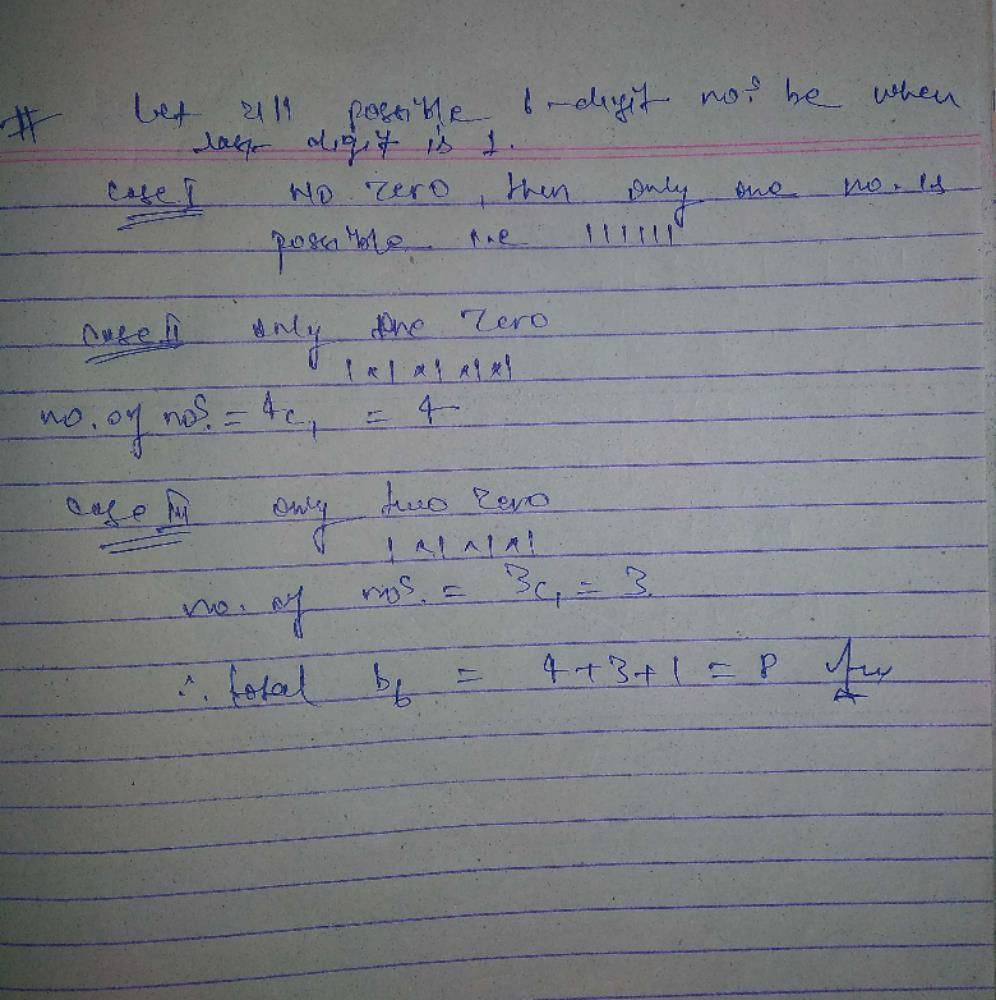
Find the largest co-efficient in the expansion of (1 + x)n, given that the sum of co-efficients of the terms in its expansion is 4096. [REE 2000 (Mains)]
Correct answer is '924'. Can you explain this answer?
Find the largest co-efficient in the expansion of (1 + x)n, given that the sum of co-efficients of the terms in its expansion is 4096. [REE 2000 (Mains)]
|
|
Ameya Iyer answered |
We know that, the coefficients in a binomial expansion is obtained by replacing each variable by unit in the given expression.
Therefore, sum of the coefficients in (a+b)^n
= 4096=(1+1)n
⇒ 4096=(2)n
⇒ (2)12=(2)n
⇒ n=12
Here n is even, so the greatest coefficient is nCn/2 i.e., 12C6 = 924
Therefore, sum of the coefficients in (a+b)^n
= 4096=(1+1)n
⇒ 4096=(2)n
⇒ (2)12=(2)n
⇒ n=12
Here n is even, so the greatest coefficient is nCn/2 i.e., 12C6 = 924
The middle term in the expansion of (2x+3y)12 is- a)

- b)

- c)

- d)

Correct answer is option 'B'. Can you explain this answer?
The middle term in the expansion of (2x+3y)12 is
a)
b)
c)
d)
|
|
Arun Khanna answered |
There will be 13 terms, so the middle term is term #7
Term(7) = C(12,6)(2x)^6 (3y)^6
= 924(64x^6)(729y^6)
= 43110144 x^6 y^6
so the correct option is B
The coefficient of second, third and fourth terms in the binomial expansion of (1+x)n(‘n’, a + ve integer) are in A.P.., if n is equal to- a)4
- b)7
- c)5
- d)6
Correct answer is option 'B'. Can you explain this answer?
The coefficient of second, third and fourth terms in the binomial expansion of (1+x)n(‘n’, a + ve integer) are in A.P.., if n is equal to
a)
4
b)
7
c)
5
d)
6
|
|
Pallabi Patel answered |
Explanation:
To find the coefficient of the second, third, and fourth terms in the binomial expansion of (1+x)^n, we need to understand the general formula for the binomial expansion and the concept of the arithmetic progression (A.P.).
Binomial Expansion:
The binomial expansion of (1+x)^n can be calculated using the binomial theorem. According to the binomial theorem, the expansion is given by:
(1+x)^n = C(n,0) + C(n,1)x + C(n,2)x^2 + C(n,3)x^3 + ... + C(n,n)x^n
where C(n,r) represents the binomial coefficient, given by:
C(n,r) = n! / (r!(n-r)!)
Arithmetic Progression (A.P.):
An arithmetic progression (A.P.) is a sequence of numbers in which the difference between any two consecutive terms is constant. The common difference between the terms is denoted by 'd'.
For an A.P., the nth term (Tn) can be calculated using the formula:
Tn = a + (n-1)d
where 'a' is the first term and 'd' is the common difference.
Coeficients in A.P.:
Now, to determine the coefficients of the second, third, and fourth terms in the binomial expansion, we need to find the values of r for which the binomial coefficients form an arithmetic progression.
From the binomial expansion formula, we can see that the coefficients C(n,1), C(n,2), and C(n,3) correspond to the second, third, and fourth terms respectively.
Let's calculate the difference between the consecutive binomial coefficients:
d1 = C(n,2) - C(n,1) = (n! / (2!(n-2)!)) - (n! / (1!(n-1)!))
= (n(n-1)(n-2)! / (2(n-2)!)) - (n(n-1)(n-2)! / (1(n-1)!))
= n(n-1)(n-2)! / (2(n-2)!) - n(n-1)(n-2)! / (1(n-1)!)
= n(n-1) / 2 - n(n-1)
= -n(n-1) / 2
d2 = C(n,3) - C(n,2) = (n! / (3!(n-3)!)) - (n! / (2!(n-2)!))
= (n(n-1)(n-2)! / (3(n-3)!)) - (n(n-1)(n-2)! / (2(n-2)!))
= n(n-1) / 3 - n(n-1) / 2
= -n(n-1) / 6
We can observe that the differences d1 and d2 are both negative and have a common factor of -n(n-1). This implies that the coefficients C(n,1), C(n,2), and C(n,3) form an arithmetic progression with a common difference of -n(n-1)/2.
Conclusion:
Since the coefficients of the second,
To find the coefficient of the second, third, and fourth terms in the binomial expansion of (1+x)^n, we need to understand the general formula for the binomial expansion and the concept of the arithmetic progression (A.P.).
Binomial Expansion:
The binomial expansion of (1+x)^n can be calculated using the binomial theorem. According to the binomial theorem, the expansion is given by:
(1+x)^n = C(n,0) + C(n,1)x + C(n,2)x^2 + C(n,3)x^3 + ... + C(n,n)x^n
where C(n,r) represents the binomial coefficient, given by:
C(n,r) = n! / (r!(n-r)!)
Arithmetic Progression (A.P.):
An arithmetic progression (A.P.) is a sequence of numbers in which the difference between any two consecutive terms is constant. The common difference between the terms is denoted by 'd'.
For an A.P., the nth term (Tn) can be calculated using the formula:
Tn = a + (n-1)d
where 'a' is the first term and 'd' is the common difference.
Coeficients in A.P.:
Now, to determine the coefficients of the second, third, and fourth terms in the binomial expansion, we need to find the values of r for which the binomial coefficients form an arithmetic progression.
From the binomial expansion formula, we can see that the coefficients C(n,1), C(n,2), and C(n,3) correspond to the second, third, and fourth terms respectively.
Let's calculate the difference between the consecutive binomial coefficients:
d1 = C(n,2) - C(n,1) = (n! / (2!(n-2)!)) - (n! / (1!(n-1)!))
= (n(n-1)(n-2)! / (2(n-2)!)) - (n(n-1)(n-2)! / (1(n-1)!))
= n(n-1)(n-2)! / (2(n-2)!) - n(n-1)(n-2)! / (1(n-1)!)
= n(n-1) / 2 - n(n-1)
= -n(n-1) / 2
d2 = C(n,3) - C(n,2) = (n! / (3!(n-3)!)) - (n! / (2!(n-2)!))
= (n(n-1)(n-2)! / (3(n-3)!)) - (n(n-1)(n-2)! / (2(n-2)!))
= n(n-1) / 3 - n(n-1) / 2
= -n(n-1) / 6
We can observe that the differences d1 and d2 are both negative and have a common factor of -n(n-1). This implies that the coefficients C(n,1), C(n,2), and C(n,3) form an arithmetic progression with a common difference of -n(n-1)/2.
Conclusion:
Since the coefficients of the second,
If in the expansion of (1 + x)m (1 – x)n, the co-efficients of x and x2 are 3 and – 6 respectively, then m is [JEE 99,2 ]- a)6
- b)9
- c)12
- d)24
Correct answer is option 'C'. Can you explain this answer?
If in the expansion of (1 + x)m (1 – x)n, the co-efficients of x and x2 are 3 and – 6 respectively, then m is [JEE 99,2 ]
a)
6
b)
9
c)
12
d)
24

|
Sushil Kumar answered |
(1+x)m (1−x)n = (1 + mx + m(m−1)x2/2!)(1 − nx + n(n−1)x2/2! )
= 1 + (m−n)x + [(n2 − n)/2 − mn + (m2 − m)/2] x2
Given m − n = 3 or n = m − 3
Hence (n2 − n)/2 − mn + (m2 − m)/2 = 6
⇒ [(m−3)(m−4)]/2 − m(m−3) + (m2 − m)/2 = −6
⇒ m2 − 7m + 12 − 2m2 + 6m + m2 − m + 12 = 0
⇒ − 2m + 24 = 0
⇒ m = 12.
= 1 + (m−n)x + [(n2 − n)/2 − mn + (m2 − m)/2] x2
Given m − n = 3 or n = m − 3
Hence (n2 − n)/2 − mn + (m2 − m)/2 = 6
⇒ [(m−3)(m−4)]/2 − m(m−3) + (m2 − m)/2 = −6
⇒ m2 − 7m + 12 − 2m2 + 6m + m2 − m + 12 = 0
⇒ − 2m + 24 = 0
⇒ m = 12.
If the expansion of  in powers of x contains the term x2r, then n−2r is
in powers of x contains the term x2r, then n−2r is- a)even
- b)odd
- c)a positive integral multiple of 5
- d)none of these
Correct answer is option 'C'. Can you explain this answer?
If the expansion of  in powers of x contains the term x2r, then n−2r is
in powers of x contains the term x2r, then n−2r is
a)
even
b)
odd
c)
a positive integral multiple of 5
d)
none of these
|
|
Geetika Shah answered |
T(r+1) = nCr xn-r ar
T(r+1) = n-5Cr xn-5-r (1/x4)r
= n-5Cr xn-5-r (1/x4r)
= n-5Cr xn-5-5r
=> n - 5 - 5r = 2r
=> n - 2r = 5(r + 1)
T(r+1) = n-5Cr xn-5-r (1/x4)r
= n-5Cr xn-5-r (1/x4r)
= n-5Cr xn-5-5r
=> n - 5 - 5r = 2r
=> n - 2r = 5(r + 1)
If the second, third, and fourth terms in the expansion of (x + y)n are 135, 30, and 10/3, respectively, then 6 (n3 + x2 + y) is equal to ________.Correct answer is '806'. Can you explain this answer?
If the second, third, and fourth terms in the expansion of (x + y)n are 135, 30, and 10/3, respectively, then 6 (n3 + x2 + y) is equal to ________.

|
Nipuns Institute answered |
T2 = nC1 y1 x(n-1) = 135
T3 = nC2 y2 x(n-2) = 30
T4 = nC3 y3 x(n-3) = 10/3
⇒ 135/30 = (x/y) * n * 2 / n(n-1) = (2 / n-1) * (x/y) ... (i)
30 / (10/3) = n(n-1) / 2 / n(n-1)(n-2) * 3! * (x/y)
9 = (3 / n-2) * (x/y)
3(n - 2) = 135 / 60 (n - 1) ⇒ n = 5
⇒ x = 9y ... (i)
y * x4 = 27 ⇒ x / 9 * x4 = 33
⇒ x5 = 35 ⇒ x = 3y = 1/3
⇒ 6 (53 + 32 + 1/3) = 6 (125 + 9 + 1/3)
= 6(134) + 2 = 806
T3 = nC2 y2 x(n-2) = 30
T4 = nC3 y3 x(n-3) = 10/3
⇒ 135/30 = (x/y) * n * 2 / n(n-1) = (2 / n-1) * (x/y) ... (i)
30 / (10/3) = n(n-1) / 2 / n(n-1)(n-2) * 3! * (x/y)
9 = (3 / n-2) * (x/y)
3(n - 2) = 135 / 60 (n - 1) ⇒ n = 5
⇒ x = 9y ... (i)
y * x4 = 27 ⇒ x / 9 * x4 = 33
⇒ x5 = 35 ⇒ x = 3y = 1/3
⇒ 6 (53 + 32 + 1/3) = 6 (125 + 9 + 1/3)
= 6(134) + 2 = 806
Number of integral terms in the expansion of (71/2 + 111/6)824 is equal to ________.Correct answer is '138'. Can you explain this answer?
Number of integral terms in the expansion of (71/2 + 111/6)824 is equal to ________.

|
Sai Kulkarni answered |
General term in expansion of (71/2 + 111/6)824 is T(r+1) = 824Cr * 7((824-r)/2) * 11(r/6)
For integral term, r must be a multiple of 6.
Hence r = 0, 6, 12, ..., 822
For integral term, r must be a multiple of 6.
Hence r = 0, 6, 12, ..., 822
n-1Cr = (k² - 8) nCr+1 if and only if:- a)2√2 < k < 2√3
- b)2√2 ≤ k ≤ 3
- c)2√3 < k < 3√3
- d)2√3 ≤ k ≤ 3√2
Correct answer is option 'B'. Can you explain this answer?
n-1Cr = (k² - 8) nCr+1 if and only if:
a)
2√2 < k < 2√3
b)
2√2 ≤ k ≤ 3
c)
2√3 < k < 3√3
d)
2√3 ≤ k ≤ 3√2

|
KP Classes answered |
n-1Cr = (k² - 8) nCr+1

(n-1Cr) / (nCr+1) = k² - 8
(r + 1) / n = k² - 8
⇒ k² - 8 > 0
(k - 2√2)(k + 2√2) > 0
k ∈ (-∞, -2√2) ∪ (2√2, ∞) .... (I)
∴ n ≥ r + 1, (r + 1) / n ≤ 1
⇒ k² - 8 ≤ 1
k² - 9 ≤ 0
-3 ≤ k ≤ 3 .... (II)
From equation (I) and (II) we get
k ∈ [-3, -2√2) ∪ (2√2, 3]

(n-1Cr) / (nCr+1) = k² - 8
(r + 1) / n = k² - 8
⇒ k² - 8 > 0
(k - 2√2)(k + 2√2) > 0
k ∈ (-∞, -2√2) ∪ (2√2, ∞) .... (I)
∴ n ≥ r + 1, (r + 1) / n ≤ 1
⇒ k² - 8 ≤ 1
k² - 9 ≤ 0
-3 ≤ k ≤ 3 .... (II)
From equation (I) and (II) we get
k ∈ [-3, -2√2) ∪ (2√2, 3]
The greatest coefficient in the expansion of (1+x)12 is- a)C (12, 4)
- b)C (12, 6)
- c)C (12, 5)
- d)none of these
Correct answer is option 'B'. Can you explain this answer?
The greatest coefficient in the expansion of (1+x)12 is
a)
C (12, 4)
b)
C (12, 6)
c)
C (12, 5)
d)
none of these
|
|
Naina Bansal answered |
The binomial expansion formula states that:
(a + b)^n = a^n + n*a^(n-1)*b + C(n,2)*a^(n-2)*b^2 + ... + b^n
where C(n,k) is the binomial coefficient, given by:
C(n,k) = n! / (k! * (n-k)!)
In the expansion of (1+x)^12, the greatest coefficient will be the one with the largest value of k. Since we are given that n = 12, the greatest coefficient will be the one with the largest value of k such that k <= n. The largest value of k that satisfies this condition is 6, which corresponds to the coefficient C(12,6).
Therefore, the greatest coefficient in the expansion of (1+x)^12 is C(12,6). The correct answer is therefore (b) C (12, 6).
If x = 9950+1005 and y = (101)50, then- a)x < y
- b)x = y
- c)x > y
- d)none of these
Correct answer is option 'A'. Can you explain this answer?
If x = 9950+1005 and y = (101)50, then
a)
x < y
b)
x = y
c)
x > y
d)
none of these
|
|
Nitya Yadav answered |
The given equations are:
Ifx = 9950
1005andy = (101)50
To solve for x, we divide both sides of the first equation by 100:
Ifx/100 = 9950/100
x = 99.5
To solve for y, we divide both sides of the second equation by 1005:
andy = (101)50/1005
andy = 50
Therefore, the values of x and y are:
x = 99.5
y = 50
Ifx = 9950
1005andy = (101)50
To solve for x, we divide both sides of the first equation by 100:
Ifx/100 = 9950/100
x = 99.5
To solve for y, we divide both sides of the second equation by 1005:
andy = (101)50/1005
andy = 50
Therefore, the values of x and y are:
x = 99.5
y = 50
Chapter doubts & questions for Binomial Theorem & its Simple Applications - Mathematics for NDA 2025 is part of NDA exam preparation. The chapters have been prepared according to the NDA exam syllabus. The Chapter doubts & questions, notes, tests & MCQs are made for NDA 2025 Exam. Find important definitions, questions, notes, meanings, examples, exercises, MCQs and online tests here.
Chapter doubts & questions of Binomial Theorem & its Simple Applications - Mathematics for NDA in English & Hindi are available as part of NDA exam.
Download more important topics, notes, lectures and mock test series for NDA Exam by signing up for free.
Mathematics for NDA
290 videos|298 docs|232 tests
|

Contact Support
Our team is online on weekdays between 10 AM - 7 PM
Typical reply within 3 hours
|
Free Exam Preparation
at your Fingertips!
Access Free Study Material - Test Series, Structured Courses, Free Videos & Study Notes and Prepare for Your Exam With Ease

 Join the 10M+ students on EduRev
Join the 10M+ students on EduRev
|

|
Create your account for free
OR
Forgot Password
OR
Signup to see your scores
go up within 7 days!
Access 1000+ FREE Docs, Videos and Tests
Takes less than 10 seconds to signup

